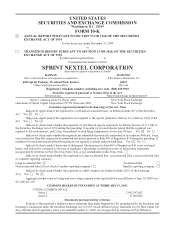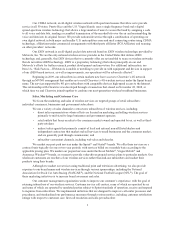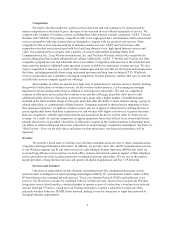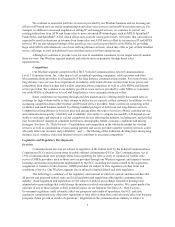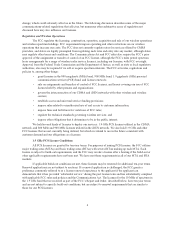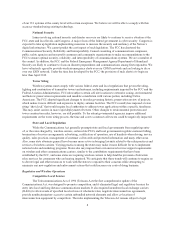Sprint - Nextel 2008 Annual Report Download - page 10
Download and view the complete annual report
Please find page 10 of the 2008 Sprint - Nextel annual report below. You can navigate through the pages in the report by either clicking on the pages listed below, or by using the keyword search tool below to find specific information within the annual report.of our 911 systems at the county level with certain exceptions. We believe we will be able to comply with this
accuracy standard using existing technology.
National Security
Issues involving national security and disaster recovery are likely to continue to receive attention at the
FCC, state and local levels, and Congress. A major focus of the federal government is cyber security. Congress is
expected to take up legislation implementing measures to increase the security and resiliency of the Nation’s
digital infrastructure. We cannot predict the cost impact of such legislation. The FCC has chartered the
Communications Security, Reliability and Interoperability Council consisting of communications companies,
public safety agencies and non-profit consumer and community organizations to make recommendations to the
FCC to ensure optimal security, reliability, and interoperability of communications systems. We are a member of
the council. In addition, the FCC and the Federal Emergency Management Agency/Department of Homeland
Security are likely to continue to focus on disaster preparedness and communications among first responders. We
have voluntarily agreed to provide wireless emergency alerts over our CDMA network and are looking to do so
over our iDEN network. Under the time line developed by the FCC, the provision of such alerts is to begin no
later than April 2012.
Tower Siting
Wireless systems must comply with various federal, state and local regulations that govern the siting,
lighting and construction of transmitter towers and antennas, including requirements imposed by the FCC and the
Federal Aviation Administration. FCC rules subject certain cell site locations to extensive zoning, environmental
and historic preservation requirements and mandate consultation with various parties, including Native
Americans. The FCC adopted significant changes to its rules governing historic preservation review of projects,
which makes it more difficult and expensive to deploy antenna facilities. The FCC recently has imposed a tower
siting “shot clock” that would require local authorities to address tower applications within a specific timeframe.
This may assist carriers in more rapid deployment of towers. Other changes to environmental protection and
tower construction rules, however, are still possible. To the extent governmental agencies impose additional
requirements on the tower siting process, the time and cost to construct cell towers could be negatively impacted.
State and Local Regulation
While the Communications Act generally preempts state and local governments from regulating entry
of, or the rates charged by, wireless carriers, certain state PUCs and local governments regulate customer billing,
termination of service arrangements, advertising, certification of operation, use of handsets when driving, service
quality, sales practices, management of customer call records and protected information and many other areas.
Also, some state attorneys general have become more active in bringing lawsuits related to the sales practices and
services of wireless carriers. Varying practices among the states may make it more difficult for us to implement
national sales and marketing programs. States also may impose their own universal service support requirements
on wireless and other communications carriers, similar to the contribution requirements that have been
established by the FCC, and some states are requiring wireless carriers to help fund the provision of intrastate
relay services for consumers who are hearing impaired. We anticipate that these trends will continue to require us
to devote legal and other resources to work with the states to respond to their concerns while attempting to
minimize any new regulation and enforcement actions that could increase our costs of doing business.
Regulation and Wireline Operations
Competitive Local Service
The Telecommunications Act of 1996 (Telecom Act) the first comprehensive update of the
Communications Act, was designed to promote competition, and it eliminated legal and regulatory barriers for
entry into local and long distance communications markets. It also required incumbent local exchange carriers
(ILECs) to allow resale of specified local services at wholesale rates, negotiate interconnection agreements,
provide nondiscriminatory access to certain unbundled network elements and allow co-location of
interconnection equipment by competitors. The rules implementing the Telecom Act remain subject to legal
8

